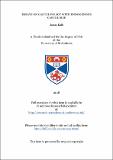Files in this item
Essays on cartel policy with endogenous cartel size
Item metadata
| dc.contributor.advisor | Ulph, David Tregear | |
| dc.contributor.author | Kalb, Jonas | |
| dc.coverage.spatial | 140 p. | en_US |
| dc.date.accessioned | 2018-10-22T13:13:20Z | |
| dc.date.available | 2018-10-22T13:13:20Z | |
| dc.date.issued | 2018-06-29 | |
| dc.identifier.uri | https://hdl.handle.net/10023/16296 | |
| dc.description.abstract | This thesis examines the role of endogenous size processes in the stability and price setting decisions of cartels. Chapter One analyses how the stability of cartels de- pends on the level of horizontal product differentiation and on costs of collusion under the premise that a cartel can consist of less than all firms in an industry. It is shown that when the size of the cartel is determined endogenously, it is possible that increased costs of collusion make a cartel more stable. Chapter Two analyses how the price setting of firms in collusive industries is affected by three different penalty regimes: i) profits, ii) overcharge, and iii) revenue based penalties. It is found that penalties influence price setting in two ways: directly, by affecting the industry price for a given cartel size and indirectly by affecting cartel size and thereby the price charged. When the penalties are equally tough, in the sense that they deter cartels over the same group of products, over- charge based penalties always lead to the lowest prices, followed by prices computed under profits based penalties and then revenue based penalties. For very few combinations of product differentiation and market size, revenue based penalties lead to lower prices than profits based penalties. Finally, Chapter Three presents a model in which collusive stability is analysed in a dynamic setting of free entry, exit and mergers. Contrary to the previous literature it shows that stable and profitable collusion is possible under free entry, without the need for cartels to play entry deterring strategies. Furthermore, the empirical evidence that a breakdown of collusion can lead to increased merger activity is replicated. An additional contribution of this model is that it defines a new notion of a long run sustainable competitive market size under merger and entry. | en_US |
| dc.language.iso | en | en_US |
| dc.publisher | University of St Andrews | |
| dc.subject | Economics | en_US |
| dc.subject | Competition policy | en_US |
| dc.subject | Cartels | en_US |
| dc.subject | Collusion | en_US |
| dc.subject | Mergers | en_US |
| dc.subject.lcc | HD2757.5K2 | |
| dc.subject.lcsh | Cartels | en |
| dc.subject.lcsh | Price fixing | en |
| dc.subject.lcsh | Competition | en |
| dc.title | Essays on cartel policy with endogenous cartel size | en_US |
| dc.type | Thesis | en_US |
| dc.contributor.sponsor | Economic and Social Research Council (ESRC) | en_US |
| dc.type.qualificationlevel | Doctoral | en_US |
| dc.type.qualificationname | PhD Doctor of Philosophy | en_US |
| dc.publisher.institution | The University of St Andrews | en_US |
This item appears in the following Collection(s)
Items in the St Andrews Research Repository are protected by copyright, with all rights reserved, unless otherwise indicated.

